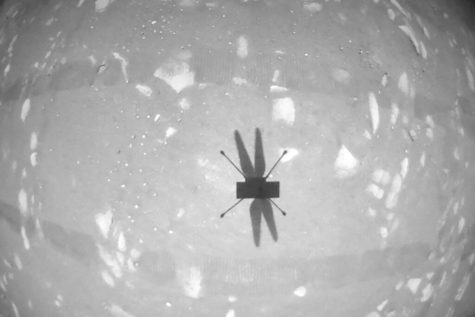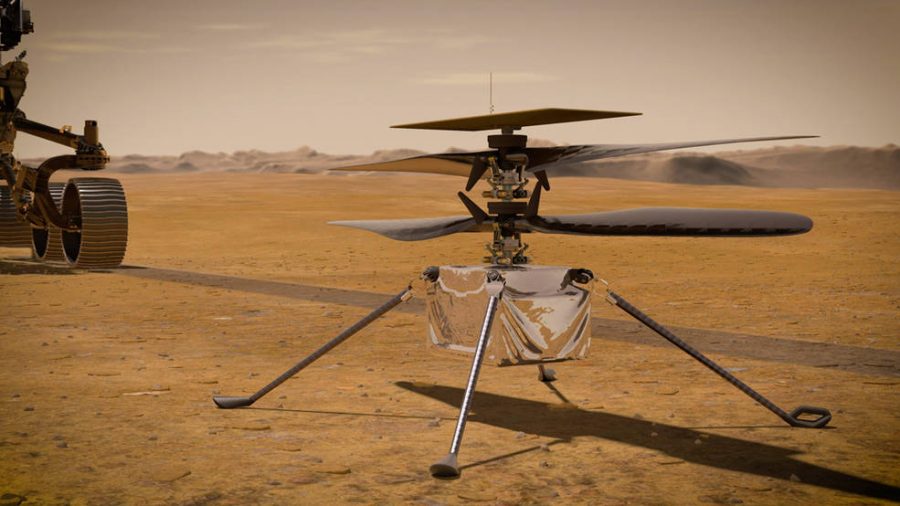The Sky’s the Limit?
Humanity’s First Successful Aircraft Flight on the Red Planet
On April 19, 2021, at 3:44 a.m. EDT, 12:33 p.m. Local Mean Solar Time, NASA’s Mars helicopter Ingenuity detached

from the red surface and ascended up to 10 feet in elevation, turned around the planet’s thin atmosphere, and settled back at its starting point. The flight lasted 39.1 seconds and marked the first ever controlled flight on Mars. The planet’s extremely thin atmosphere has only 1% of the pressure found on Earth which poses a major challenge; the extremely low pressure means that the aircraft doesn’t have many molecules to interact with in the atmosphere. To tackle the technical challenge, NASA’s Jet Propulsion Laboratory, the team that built Ingenuity, used ultra light materials that could spin at approximately 2,400 rotations per minute. With ultralight materials, fast-spinning blades, and high-powered computer processing, the craft overcame this major obstacle. Engineering a solution to face Mars’s environmental factors was no simple matter. As Håvard Grip, Ingenuity’s chief pilot stated in a NASA news release: “It sounds simple, but there are many unknowns regarding how to fly a helicopter on Mars. That’s why we’re here — to make these unknowns known.”
The key purpose of the helicopter is to carry the belly of the Perseverance rover, which is meant to explore any signs of ancient life on Mars. The technology collects rocks and soil samples that would be returned to the NASA laboratory and assessed for any signs of microbial life. Moreover, one of the key objectives of Perseverance is to demonstrate future human capability for robotic exploration in space. Eviden
ce from orbital missions prove that today, Mars is a far more cold, dry climate than it was two decades ago. Therefore, it is very likely that the planet once possessed living creatures! Ingenuity is the helicopter-rover complex that is meant to carry Perseverance around the planet in order to avoid any damaging clashes against unexpected obstacles.
On April 22nd, the Mars helicopter logged a second successful flight. In contrast to its previous flight, the second added the new challenges of a higher maximum altitude, a longer duration, and sideways movement. This time, the flight reached 16 feet above the ground, lasting as long as 59.1 seconds in the air. What’s more, the team expanded its goals for the aircraft’s camera. Whereas in its first flight, the camera was in full zoom mode for both its launching and landing zones, the second flight sought to zoom out and cover a wider field to capture more of the flight. Since the second flight also succeeded from start to finish and accomplished its anticipated reach, the team is planning on its next steps to best acquire additional aeronautical data from its first flight tests on Mars.
For many, this achievement is a gigantic milestone for the future of humanity.
“The coolest thing about it is the proof of science,” said Joshua Winter, our school’s AP Physics teacher and an avid explorer of aircraft engineering. “The Wright brothers were able to move a plane using the wood and paper model of an airplane. Although not very useful, this was the first time we had a powered flight. Other humans came along and improved on that. Within 20 years we had jet riders.”
“Next time, instead of limiting a rover on Mars and worrying about whether it will hit a rock and shut down, we can move much quicker and learn information much faster,” said Mr. Winter. “The main purpose was to see if we can do it. We are no longer limited to ground exploration.”
As Mr. Winter said the flight did in fact open up a whole new world of question marks to test in the years to come. For instance, NASA recently reported that the success of the rover calls for the launching of MOXIE, an oxygen generator meant to break up carbon dioxide molecules in the Martian air. This technology would be critical for astronauts arriving from Earth and it creates a propellant for the return home. The Ingenuity team keeps its aims high; Bob Balaram, the chief engineer of Ingenuity said he and his colleagues began planning out designs to send a larger helicopter 10 times the mass of Ingenuity, capable of carrying 10 times the mass of equipment.
The vivid success in April achieved a space exploration goal that not so long ago was thought to be impossible. It is thrilling to think where Ingenuity will lead us. All we know is that the sky (at least on Mars) is definitely not the limit.
Daniela is a senior at BASIS Independent Brooklyn. She is very interested in cognitive neuroscience. Outside of school you will find her reading, sketching,...












